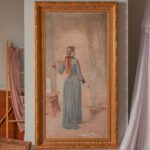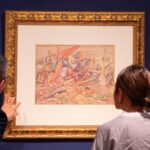During this holiday season, we find ourselves engaged in activities and events that bring us closer to our loved ones. All year, we wait in anticipation to attend Simbang Gabi, also known as the Dawn Mass, with our family and friends. Here, we relive the first Christmas by watching the Panunuluyan, a short play that reenacts the birth of Christ.
Afterward, just outside the doors of the church, we’re greeted warmly by the inviting aroma of steamed puto bumbong, bibingka that has just been taken off the coal, and the caramelized scent of tsokolate. These seasonal breakfast treats make the early wake-up call well worth the effort.
The celebration extends well beyond the walls of the church. In our family homes, we often gather for reunions and for Noche Buena一 the meal we share with our loved ones on Christmas Eve.
An integral part of all these intimate celebrations are the revered and beloved chairs used both in homes and churches. These treasured moments spent together during the holidays are what make the humble chair an infallible companion and witness to one of life’s most joyous and important celebrations.
Since we’ll be celebrating the holidays differently this year, we thought we’d take a closer look at this overlooked hero of thousands of gatherings all over the country.
Gathering Around the Chair: Popular Chairs in Philippine Colonial History
The First Chairs
The idea of chairs that we have today is heavily influenced by the Spaniards, who first brought the European chairs to our shores. Prior to their arrival, pre-colonial Philippines had a rather different version of the chair.
Pre-colonial leaders like datus, reynas, and rajahs of each barangay would sit upon ornate cushions as they interacted with their constituents. These cushions were reserved mainly for the use of the elites in early society.
The first chairs seen by the early Filipinos came from Ferdinand Magellan’s galleon ships. Called Sillion de Cadera, they were derived from a design used in Ancient Rome. These opulent chairs, covered with red and purple velvet, were used for the historic mass on Limasawa Island in 1521.
Constituents would eventually gather around chairs in order to commune with their leaders. Seats were arranged in such a way that one’s position at table was indicative of his or her place in society. Just think of how particular and finicky Padre Damaso was about his place at the table in Jose Rizal’s magnum opus, Noli Me Tangere. Now we understand what all the fuss was about!.
The Effects of the Manila Galleon Trade
In many ways, the Manila galleon trade began to democratize the use of the chair. The sudden boom in goods and resources across the country allowed craftsmen to experiment with a variety of designs that were more aligned with the aesthetics and styles of the changing milieu.
In a few short decades, we went from owning bare and straight-back furniture reserved for social and political elites to commissioning lavish chairs for our homes and churches.
In the late 17th century, many churches began to have chairs with baroque carvings of acanthus leaves, angels, and cartouches commissioned exclusively for the bishops. Thus the aptly named bishop’s chair. Meanwhile, long benches with straight backs were designed for the use of wealthy parishioners.
This era witnessed the creation of the chairs and seats we commonly find in our family homes today. As the country grew in prosperity, so did the variety of furniture. The chairs, armchairs, recliners, gallineras, capiyas, settees, rocking chairs and sofas that were once made only for the church were now staples in the most opulent homes.
The Age of Modernity
America’s occupation of the Philippines introduced the mass-production of chairs in the country. These were no longer a status symbol, rather, they became a common fixture in every home, church, and place of gathering.
The nature-inspired Art Nouveau style and the clean, geometric lines of Art Deco style dominated the chair designs from this era
Families gathered to listen to the radio, watch movies; and together with throngs of people, enjoy bodabil (vaudeville), stage plays and carnival festivals outdoors. This joyful and lively spirit carried over well into the holiday season.
Which brings us back to the traditions we grew up with and continue to celebrate to this day!
All of these chairs are part of Gavel&Block’s Under the Tree online auction which will be held live on our website on Saturday 21 November at 11 am. You may click here to view our online catalog and virtual gallery.
















